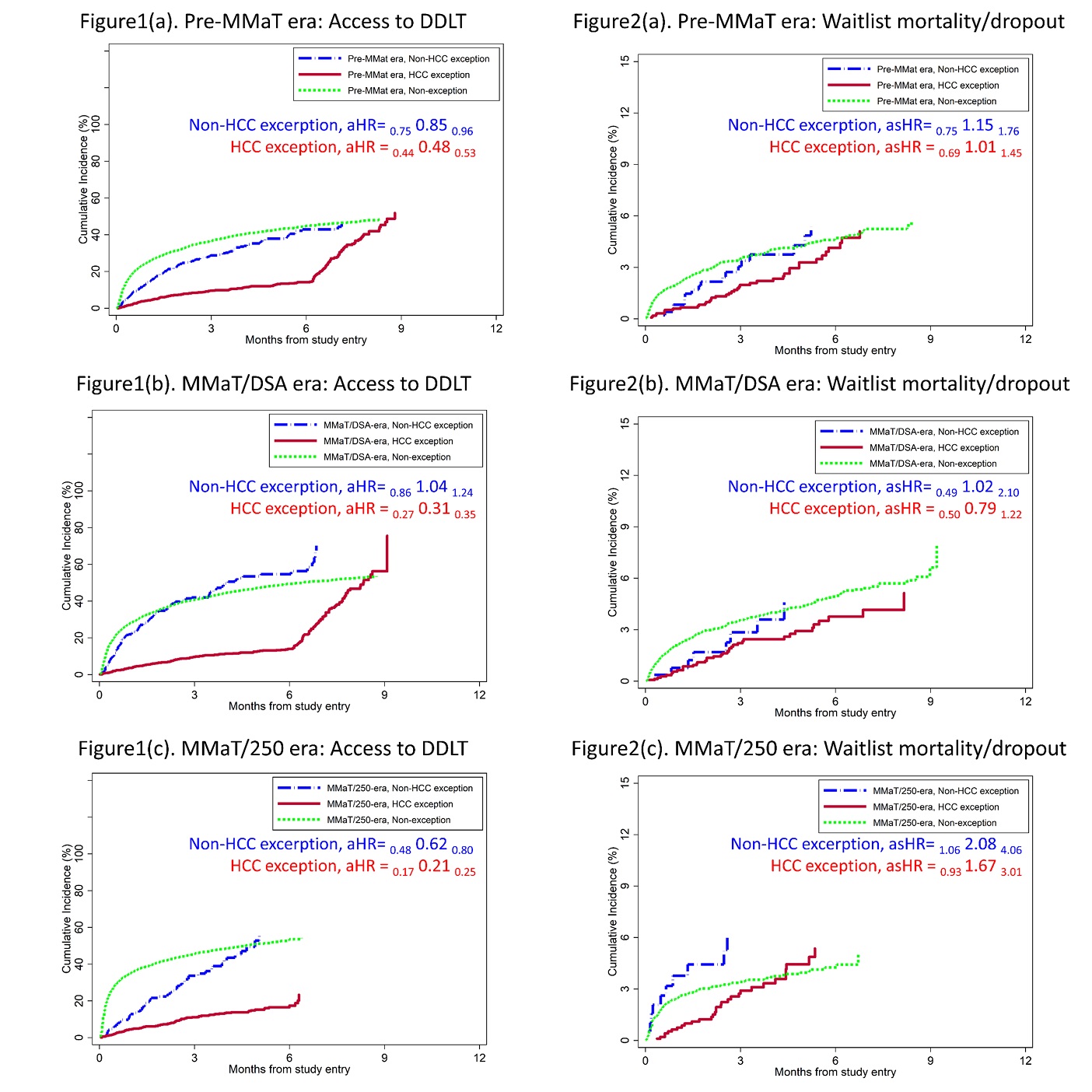Waitlist Outcomes for Exception Candidates Following the Implementation of MMaT/250 Score
1Johns Hopkins Medical Institutions, Baltimore, MD, 2Temple University, Philadelphia, PA
Meeting: 2021 American Transplant Congress
Abstract number: 1147
Keywords: Allocation, Hepatocellular carcinoma, Liver transplantation, Mortality
Topic: Clinical Science » Liver » Liver: MELD, Allocation and Donor Issues (DCD/ECD)
Session Information
Session Name: Liver: MELD, Allocation and Donor Issues (DCD/ECD)
Session Type: Poster Abstract
Session Date & Time: None. Available on demand.
Location: Virtual
*Purpose: Starting in May 2019, exception points were allocated based on DSA-level median-MELD-at-transplant (MMaT/DSA). In February 2020, the exception point system was further modified based on MMaT within 250 nautical miles (MMaT/250). Our aim was to describe subsequent changes in transplant and mortality rates for exception and non-exception candidates.
*Methods: Using SRTR data on 26,992 adult, first-time, active, DDLT waitlist registrants, we compared DDLT rates in non-HCC exception vs. HCC-exception vs. non-exception candidates using Cox regression in three eras: Pre-MMat (02/01/2018-01/31/2019), MMaT/DSA (05/01/2019-02/03/2020), and MMaT/250 (02/04/2020-08/30/2020). In addition, we compared waitlist mortality/dropout risk among non-HCC exception, HCC-exception, non-exception candidates of the same allocation priority using Fine and Gray method after accounting for the competing risk of transplantation.
*Results: During pre-MMat era, Non-HCC exception candidates had 15% (aHR= 0.75 0.85 0.96) lower access to DDLT compared to non-exception candidates; similar DDLT rate in MMaT/DSA-era (aHR= 0.86 1.04 1.24) and then attenuated to 38% lower access to DDLT in MMaT/250 era (aHR=0.48 0.62 0.80) (Figure 1). HCC-exception candidates had 52 % (aHR=0.44 0.48 0.53), 69% (aHR=0.27 0.31 0.35) and 79% (aHR=0.17 0.21 0.25) lower access to DDLT compared to non-exception candidates during pre-MMat , MMaT/DSA and MMaT/250 era , respectively. Non-HCC exception and non-exception candidates with the same allocation MELD had comparable risk of death/dropout during pre-MMaT and MMaT/DSA eras (Figure 2). However, under MMaT/250, non-HCC exception patients had twice as much risk of death/dropout compared to non-exception patients (asHR= 1.06 2.08 4.06); risk was potentially elevated for HCC exception patients although not statistically significant (asHR = 0.93 1.67 3.01) (Figure 2).
*Conclusions: Following the implementation of MMaT/250 score, access to DDLT was attenuated for both Non-HCC exception and HCC exception candidates. In addition, the policy change appeared to have substantially increased risk of death/dropout for non-HCC exception candidates compared to non-exception candidates. The COVID-19 pandemic may have influenced death/dropout in the MMaT/250 era.
To cite this abstract in AMA style:
Ishaque T, Wang JG, Karhadkar S, Segev D, Massie AB. Waitlist Outcomes for Exception Candidates Following the Implementation of MMaT/250 Score [abstract]. Am J Transplant. 2021; 21 (suppl 3). https://atcmeetingabstracts.com/abstract/waitlist-outcomes-for-exception-candidates-following-the-implementation-of-mmat-250-score/. Accessed January 7, 2026.« Back to 2021 American Transplant Congress

